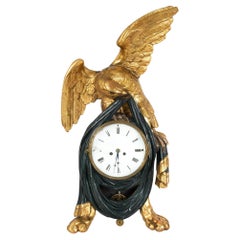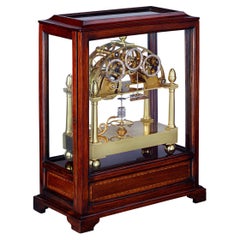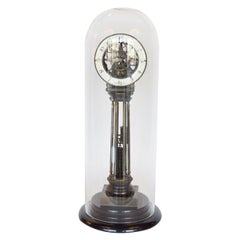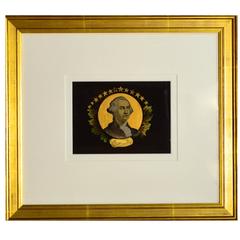Antique Clock Reverse Glass Painting
Antique Early 19th Century Austrian Neoclassical Wall Clocks
Iron
People Also Browsed
Antique 19th Century English Victorian Mantel Clocks
Brass
Antique 18th Century French Table Clocks and Desk Clocks
Brass
Antique 19th Century French Mantel Clocks
Belgian Black Marble, Bronze
Antique 1810s Austrian Empire Mantel Clocks
Brass, Enamel
Antique 1820s Austrian Empire Sterling Silver
Brass
Antique 19th Century French Louis XIV Grandfather Clocks and Longcase Cl...
Ebony, Mahogany
Antique Mid-18th Century Swedish Rococo Wall Clocks
Metal
Antique 19th Century Swedish Grandfather Clocks and Longcase Clocks
Metal
Antique Early 19th Century Swedish Neoclassical Wall Clocks
Giltwood
Antique Early 19th Century Swedish Empire Wall Clocks
Wood
Antique 19th Century Egyptian Revival Mantel Clocks
Antique Early 19th Century Swedish Grandfather Clocks and Longcase Clocks
Wood
Antique 19th Century Swedish Grandfather Clocks and Longcase Clocks
Wood, Plaster
Antique Late 18th Century Swedish Rococo Clocks
Giltwood
Antique Late 18th Century Swedish Gustavian Wall Clocks
Iron, Lead
Antique 19th Century British Victorian Grandfather Clocks and Longcase C...
Mahogany
Recent Sales
Antique Mid-19th Century American American Classical Historical Memorabilia
Glass
Antique Mid-18th Century American American Classical Historical Memorabilia
Glass
A Close Look at neoclassical Furniture
Neoclassical design emerged in Europe in the 1750s, as the Age of Enlightenment reached full flower. Neoclassical furniture took its cues from the styles of ancient Rome and Athens: symmetrical, ordered, dignified forms with such details as tapered and fluted chair and table legs, backrest finials and scrolled arms.
Over a period of some 20 years, first in France and later in Britain, neoclassical design — also known as Louis XVI, or Louis Seize — would supersede the lithe and curvaceous Rococo or Louis XV style.
The first half of the 18th century had seen a rebirth of interest in classical antiquity. The "Grand Tour" of Europe, codified as a part of the proper education of a patrician gentleman, included an extended visit to Rome. Some ventured further, to sketch the ruins of ancient Greece. These drawings and others — particularly those derived from the surprising and rich archaeological discoveries in the 1730s and ’40s at the sites of the Roman cities of Pompeii and Herculaneum — caused great excitement among intellectuals and aesthetes alike.
Neoclassical furniture is meant to reflect both grace and power. The overall appearance of neoclassical chairs, tables and cabinetry is strong and rectilinear. These pieces are, in effect, classical architecture in miniature: chair and table legs are shaped like columns; cabinets are constructed with elements that mirror friezes and pediments.
Yet neoclassicism is enlivened by gilt and silver leaf, marquetry, and carved and applied ornamental motifs based on Greek and Roman sculpture: acanthus leaves, garlands, laurel wreaths, sheaves of arrow, medallions and chair splats are carved in the shapes of lyres and urns. Ormolu — or elaborate bronze gilding — was essential to French design in the 18th and 19th centuries as a cornerstone of the neoclassical and Empire styles.
As you can see from the furniture on these pages, there is a bit of whimsy in such stately pieces — a touch of lightness that will always keep neoclassicism fresh.
Find antique neoclassical furniture today on 1stDibs.
Read More
What Is Ormolu, and Why Are We Talking about It?
This golden material glamorized neoclassical furnishings and transformed upper-crust sitting rooms from France to Philadelphia in the 18th and early 19th centuries.
New York’s Hirschl & Adler Showcases the American Workmanship and Design Panache of Neoclassical Treasures
The gallery's latest exhibition proves that museum-quality pieces entice and inspire, whether in traditional or more modern interiors.
Susanna Salk’s Favorite Designers Show Us How to Play with Patterns
Taking us on a whirlwind tour of spaces that use charming prints with aplomb, the interiors expert makes a compelling case for ditching staid solids when tackling your next decorating project.
6 Creative Ways to Decorate with Sculpture Busts
Just because a statue looks classical doesn't mean it has to be conventional. Designers share their tips for placing busts in the perfect spot.




